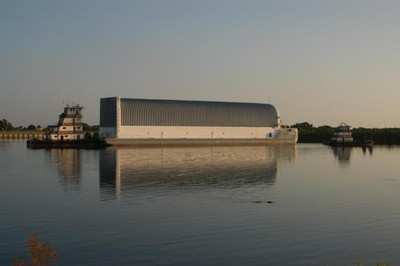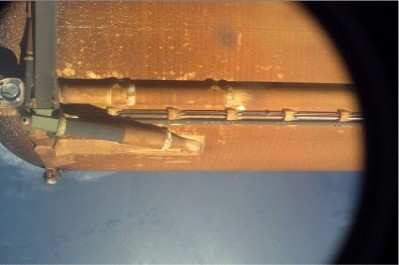Thu, Sep 29, 2005
Michoud Has Recovered Enough To Start Research On STS-114 Foam
Loss
Less than a month after being hit by Hurricane Katrina, NASA's
Michoud Assembly Facility in New Orleans is gearing up to restart
processing space shuttle fuel tanks. The work will address foam
loss during Space Shuttle Discovery's launch in July.

External tank #119, which is expected to be used in the next
shuttle mission, departed NASA's Kennedy Space Center in Florida
today. The huge, orange external tank is being transported by
NASA's solid rocket booster retrieval ship Freedom Star. It will
travel down Florida's Banana River en route to the Gulf of
Mexico-Mississippi River outlet on its 900-mile journey. It's
expected to arrive at Michoud in four or five days.
"The facility is ready to receive the tank and the Michoud team
is eager to get their hands on it," said External Tank Project
Manager Sandy Coleman. Michoud workers will begin limited testing
on the tank as soon as it arrives. Hurricane recovery efforts at
the facility have progressed better than anticipated. Power has
been restored to the entire Michoud complex, and temporary repairs
have been made to damaged buildings. External tank #120 will be
shipped from Kennedy to the facility in the next few weeks.
The external tank, 27.6 feet wide and 154 feet tall, is the
largest element of the shuttle system, which also includes the
orbiter, main engines and solid rocket boosters. Despite the tank's
size, its aluminum skin is only one-eighth-inch thick in most
areas, but withstands more than 6.5 million pounds of thrust during
liftoff and ascent. The tank is the only shuttle component that
cannot be reused.

During a launch, the external tank delivers 535,000 gallons of
liquid hydrogen and oxygen propellants to the three main engines,
which power the shuttle to orbit. The tank is covered by
polyurethane-like foam, with an average thickness of about one
inch. The foam insulates the propellants, keeps ice from forming on
the tank's exterior and protects its aluminum skin from aerodynamic
heat during flight.
The Space Shuttle Propulsion Office at NASA's Marshall Space
Flight Center manages the tank project. Lockheed Martin Space
Systems Co., New Orleans, is the primary contractor.
More News
He Attempted To Restart The Engine Three Times. On The Third Restart Attempt, He Noticed That Flames Were Coming Out From The Right Wing Near The Fuel Cap Analysis: The pilot repor>[...]
Make Sure You NEVER Miss A New Story From Aero-News Network Do you ever feel like you never see posts from a certain person or page on Facebook or Instagram? Here’s how you c>[...]
From 2009 (YouTube Edition): Leading Air Show Performers Give Their Best Advice for Newcomers On December 6th through December 9th, the Paris Las Vegas Hotel hosted over 1,500 air >[...]
Aero Linx: NASA ASRS ASRS captures confidential reports, analyzes the resulting aviation safety data, and disseminates vital information to the aviation community. The ASRS is an i>[...]
“For our inaugural Pylon Racing Seminar in Roswell, we were thrilled to certify 60 pilots across our six closed-course pylon race classes. Not only did this year’s PRS >[...]
 NTSB Final Report: Rutan Long-EZ
NTSB Final Report: Rutan Long-EZ ANN FAQ: Turn On Post Notifications
ANN FAQ: Turn On Post Notifications Classic Aero-TV: ICAS Perspectives - Advice for New Air Show Performers
Classic Aero-TV: ICAS Perspectives - Advice for New Air Show Performers ANN's Daily Aero-Linx (06.28.25)
ANN's Daily Aero-Linx (06.28.25) Aero-News: Quote of the Day (06.28.25)
Aero-News: Quote of the Day (06.28.25)




